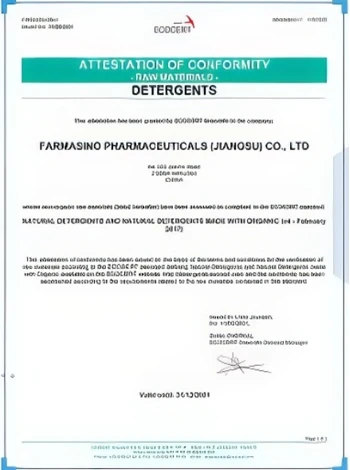



chemical formula of sodium chlorate
Understanding the Chemical Formula of Sodium Chlorate
Sodium chlorate is an important chemical compound that plays a significant role in various industrial applications. Its chemical formula is NaClO₃, which indicates that it is composed of sodium (Na), chlorine (Cl), and oxygen (O) atoms. This article aims to delve into the structure, properties, production, and applications of sodium chlorate, helping to elucidate the importance of this compound in both industrial and laboratory settings.
Structure and Composition
The chemical formula NaClO₃ reveals that one molecule of sodium chlorate contains one sodium atom, one chlorine atom, and three oxygen atoms. The sodium ion, Na⁺, is a cation that is formed when sodium loses an electron. Chlorine in sodium chlorate exists in the +5 oxidation state, distinguishing it from other chlorates like potassium chlorate (KClO₃), where the cation differs. The three oxygen atoms are covalently bonded to the chlorine atom, forming a chlorate ion (ClO₃⁻). The overall structure is relatively straightforward but crucial for the properties and reactivity of the compound.
Properties of Sodium Chlorate
Sodium chlorate is a white crystalline solid that is highly soluble in water. It is considered to be a strong oxidizing agent, which makes it effective in various chemical reactions. Its melting point is approximately 250 °C, and it decomposes upon heating, releasing oxygen gas. Sodium chlorate can be quite reactive, especially in the presence of organic materials or other reducing agents, leading to potential hazards if not handled properly.
Due to its oxidizing properties, sodium chlorate is commonly used in the production of chlorine dioxide, a powerful bleaching agent and disinfectant. Additionally, the compound can also serve as a herbicide and defoliant in agricultural practices, showcasing its versatility in different sectors.
chemical formula of sodium chlorate

Production of Sodium Chlorate
The industrial production of sodium chlorate is typically achieved through the electrolysis of a sodium chloride solution. In this process, electric current is passed through the aqueous solution of sodium chloride, facilitating the oxidation of chlorine to form chlorine gas, which then reacts with sodium hydroxide (NaOH) to produce sodium hypochlorite (NaOCl). With continued electrolysis, sodium hypochlorite can further convert into sodium chlorate. This method not only ensures a consistent supply of sodium chlorate but also allows for the recycling of by-products.
Applications of Sodium Chlorate
Sodium chlorate finds applications in various fields. One of the primary uses is in the paper and pulp industry, where it is used for bleaching purposes. Its ability to break down lignin in wood fibers makes it an essential agent in producing high-quality paper. Additionally, it is utilized in the production of herbicides to control unwanted vegetation in agricultural fields.
Furthermore, sodium chlorate has found a niche in the textile industry as a bleaching agent and is utilized in the manufacturing of explosives due to its oxidizing properties. However, handling sodium chlorate requires caution, as its oxidizing nature can pose fire and explosion risks when combined with combustible materials.
Conclusion
Sodium chlorate, with its chemical formula NaClO₃, serves as a pivotal compound in various industrial applications. From its structural components to its production methods and widespread uses, understanding sodium chlorate highlights the significance of chemical compounds in our daily lives. As with many chemicals, responsible handling and awareness of its properties are essential to harness its benefits while minimizing risks.
-
Why Sodium Persulfate Is Everywhere NowNewsJul.07,2025
-
Why Polyacrylamide Is in High DemandNewsJul.07,2025
-
Understanding Paint Chemicals and Their ApplicationsNewsJul.07,2025
-
Smart Use Of Mining ChemicalsNewsJul.07,2025
-
Practical Uses of Potassium MonopersulfateNewsJul.07,2025
-
Agrochemicals In Real FarmingNewsJul.07,2025
-
Sodium Chlorite Hot UsesNewsJul.01,2025










